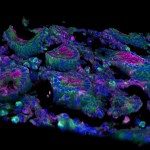Link to Pubmed [PMID] – 31414660
Link to DOI – 10.1684/vir.2019.0783
Virologie (Montrouge) 2019 08; 23(4): 229-240
Even today, despite triple therapy, the epidemic of the human immunodeficiency virus (HIV) is a major public health problem. In this perspective, continuous research is essential for the development of curative and vaccinal approaches. Animal models contribute to the implementation of new therapeutic and preventive strategies. We present here the characteristics of major animal models of HIV, which are non-human primates (SIV or SHIV-infected macaques and natural hosts of SIV), as well as different humanized mouse models and their advances. We will also list how they have already allowed, and still allow today, to broaden our knowledge on the physiopathology of HIV infection, tissue distribution of the virus, viral reservoirs, immunological responses against the virus in the very early infection stages and at the tissue level, but also in the development of vaccine candidates (RhCMV, broad-spectrum antibodies, etc…) and clinical trials for a cure. The advantages and limitations of the different animal models will be described. While continuing research on alternative methods, refinement or reduction of the animal model, a good knowledge of the specificities of each animal model allows an adequate use in relation to the scientific questions addressed.


